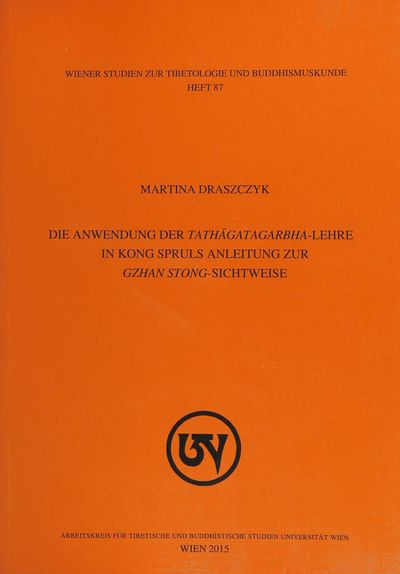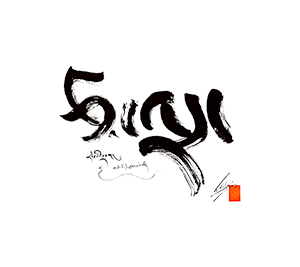- Inhalt
- Vorwort8
- 1 Einleitung
- 1.1 Zielsetzung11
- 1.2 Methode und Abgrenzung des Themas13
- 1.3 ’Jam mgon Kong sprul Blo gros mtha’ yas, sein Leben und Wirken
- 1.3.1 Kong sprul und die ris med Bewegung16
- 1.3.2 Publikationen zu Kong sprul24
- 1.3.3 Wesentliche Ereignisse im Leben von Kong sprul, eine Chronologie32
- 1.3.4 Kong spruls literarisches Lebenswerk, die mDzod Inga („Fünf Schätze“)47
- 1.4 Das Thema der Buddha-Natur
- 1.4.1 Mahāyāna-Schriften zur Buddha-Natur und ihre Datierung52
- 1.4.2 Einschlägige Mahāyāna-Sūtren aus Sicht der tibetischen Exegese55
- 1.4.3 Indische Lehrwerke zur positiven Beschreibung der absoluten
Wirklichkeit59 - 1.4.4 Wissenschaftliche Arbeiten zur Buddha-Natur bzw. damit verwandten
Themen64
- 2 Der Ratnagotravibhāga in Tibet
- 2.1 Der Ratnagotravibhāga in der tibetischen Exegese74
- 2.2 Für die Karma bKa’ brgyud pa-Tradition wesentliche Ratnagotravibhāga
Überlieferungen - 2.2.1 Maitrīpas Lehrtradition76
- 2.2.2 Sajjanas tibetische Schüler77
- 2.3 Stellung des Ratnagotravibhāga in den mahāmudrā-Lehren der Karma
bKa’ brgyud pa-Tradition84
- 3 gzhan stong in Tibet
- 3.1 gzhan stong, Allgemeines94
- 3.2 Grundlagen für die tibetische gzhan stong-Exegese in indischen Lehrwerken99
- 3.3 gzhan stong-Mādhyamikas in Tibet bzw. Lehrer, in deren Wirken sich
Elemente der gzhan stong-Lehre finden104 - 3.4 gzhan stong-Proponenten in der Darstellung von Kong spruls gZhan stong
lta khrid, Gemeinsamkeiten und Unterschiede - 3.4.1 Allgemeine Bemerkungen113
- 3.4.2 Von Kong sprul als Wegbereiter der gzhan stong-Lehren bezeichnete
tibetische Lehrer - 3.4.2.1 Karma pa Rang byung rdo rje116
- 3.4.2.2 Dol po pa Shes rab rgyal mtshan132
- 3.4.2.3 Klong chen pa Dri med ’od zer138
- 3.4.3 Weitere von Kong sprul als gzhan stong-Proponenten bezeichnete Lehrer145
- 3.4.3.1 Karma pa Chos grags rgya mtsho145
- 3.4.3.2 Shākya mchog ldan150
- 3.4.3.3 Tāranātha Kun dga’ snying po155
- 3.4.3.4 Si tu Chos kyi ’byung gnas160
- 3.5 Kong spruls Sichtweise165
- 4 Kong spruls gZhan stong lta khrid: „Die makellosen Lichtstrahlen des vajra-Mondes,
eine Anleitung zur Sichtweise von gzhan stong, dem Großen Madhyamaka“ - 4.1 Das gZhan stong lta khrid in Kong spruls Werken, allgemeine Beschreibung des
Textes195 - 4.2 lta khrid als Literaturgattung; Zweck und Verwendung197
- 4.3 Aufbau von Kong spruls gZhan stong lta khrid
- 4.3.1 Struktur des Textes200
- 4.3.2 Inhaltliche Schwerpunkte in Kong spruls gZhan stong lta khrid
- 4.3.2.1 Die drei Lehrzyklen, ihre hinführende und/oder definitive Bedeutung und
die exegetische Zuordnung des Ratnagotravibhāga202 - 4.3.2.2 Die im gZhan stong lta khrid dargestellte Anleitung gemäß der Sūtra-Tradition:
- 4.3.2.2.1 „Was zu verstehen ist“
- 4.3.2.2.1.1 Die weltliche und die überweltliche Sichtweise214
- 4.3.2.2.1.2 Sichtweise und Meditation gemäß dem Niḥsvabhāvavāda-
Madhyamaka220 - 4.3.2.2.1.3 Mögliche Fehlerquellen beim Niḥsvabhāvavāda-Madhyamaka231
- 4.3.2.2.1.4 Sichtweise und Meditation gemäß des Yogācāra-Madhyamaka234
- 4.3.2.2.1.5 Kong spruls Sicht zur nicht-zweiheitlichen Gnosis238
- 43.2.2.2„Die eigentliche Praxis“ gemäß der Sūtra-Tradition
- 4.3.2.2.2.1 „Die Vorbereitung“ 240
- 4.3.2.2.2.2 „Der Hauptteil“
- 4.3.2.2.2.2.1 „Die Zufluchtnahme und das Entwickeln von bodhicitta“ 242
- 4.3.2.2.2.2.2 „Die Anleitung zur meditativen Übung der Einheit von śamatha
und vipaśyanä“244 - 4.3.2.2.2.2.3 „Das genaue Unterscheiden und die dadurch erfolgende Einführung
in die Buddha-Natur“258 - 4.3.2.2.3 Die Praxis außerhalb der Meditation273
- 4.3.2.3 Die im gZhan stong lta khrid dargestellte Anleitung gemäß der Tantra-
Tradition - 4.3.2.3.1 Vorbemerkungen282
- 4.3.2.3.2 „Was zu verstehen ist“283
- 4.3.2.3.3 „Die eigentliche Praxis“291
- 4.3.2.4. „Der Nutzen“294
- 4.4 Textedition und Übersetzung
- 4.4.1 Anmerkungen zur tibetischen Textausgabe297
- 4.4.2 Anmerkungen zu Edition und Übersetzung300
- 4.4.3 Inhaltsübersicht des gZhan stong lta khrid mit Seitenverweis auf Edition
und Übersetzung302 - 4.4.4 Edition des tibetischen Textes303
- 4.4.5 Übersetzung323
Abkürzungen, Bibliografie und Indices
- Allgemeine Abkürzungen353
- Indische Werke354
- Tibetische Werke356
- Sekundärliteratur364
- Internet379
- Indices380



